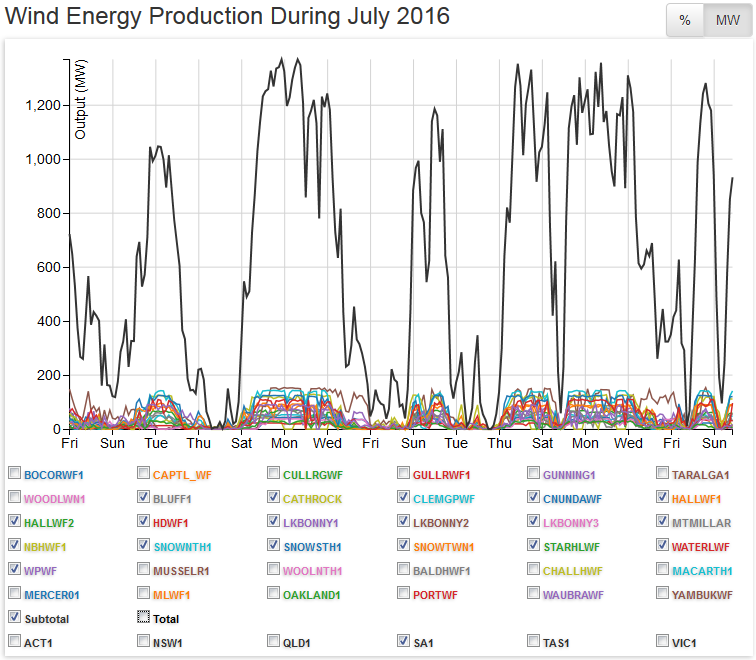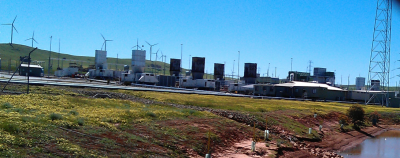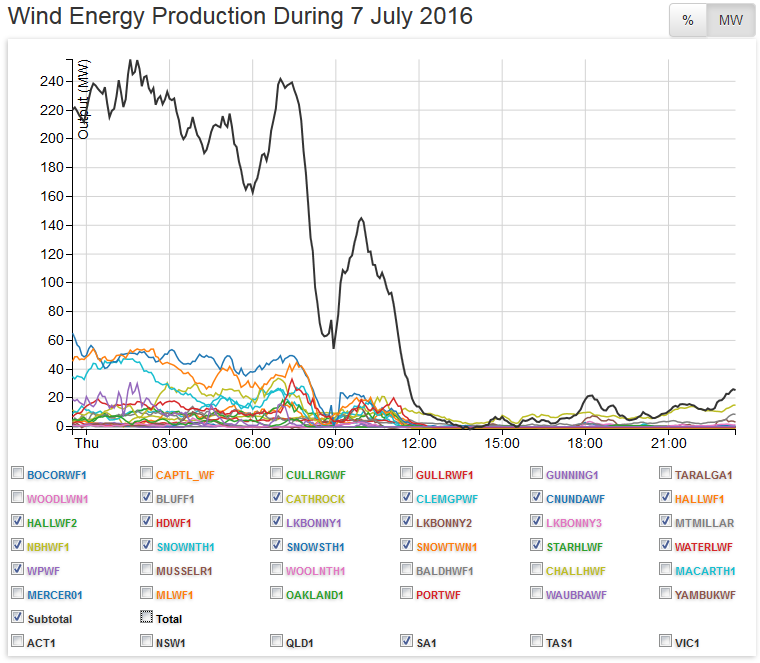
Continuing our focus on Australia’s “wind power capital”, South Australia and its self-inflicted energy disaster, here is another story outlining the debacle, this time from The Advertiser.
BHP’s SA power bill hit $2.5m – on a single day
The Advertiser
Luke Griffiths
16 July 2016
THE power bill of the state’s largest private employer recently topped $2.5 million on one day – more than 10 times that paid a week earlier.
Analysis undertaken by The Advertiser found that last Thursday, BHP’s operations in SA consumed an estimated $2.57 million of power for its 120MW/h requirements. The previous week its daily cost was $250,400.
Evidence of the incredible market volatility comes as figures from the Australian Energy Market Operator show that in the first calendar month since Alinta switched off its 544MW Northern power station in Port Augusta, the average peak price in SA was $160.45MW/h – 158 per cent above that in the month leading up to the May 9 closure.
Recent price spikes – caused by a lack of baseload generation and inconsistent supply from renewable sources – this week prompted Treasurer Tom Koutsantonis to take the extraordinary step of requesting AGL to produce more energy at its Pelican Point facility.
The move came after a number of companies told the State Government they were considering temporary shutdowns. SA was left particularly vulnerable this week because upgrade work on the Victorian interconnector was delayed due to bad weather.
Last Thursday, five of the state’s largest consumers – BHP, Nyrstar, Arrium, Brighton, and OZ Minerals – collectively consumed $6.1 million of power, according to an analysis conducted using AEMO data. That compares to $594,100 just seven days prior.
A BHP spokeswoman would not confirm the company’s power costs, citing commercial-in-confidence.
However, at an event last Friday, BHP Olympic Dam asset president Jacqui McGill said she was “very keen” to see prices come down, adding: “You know our business is tied to the state. What I’m concerned about (for SA) is for those businesses who aren’t tied here and what the potential impact of that higher pricing will mean for them.” Alinta has declined to comment on recent price volatility.
Arrium is using a range of measures to manage its power use, including throttling, closures, and alternate generation. It has a greater ability than BHP to reduce aspects of its consumption – but this can lead to significant extra production costs.
SA Chamber of Mines and Energy chief executive Jason Kuchel said other states viewed SA’s electricity market like a “canary in the coalmine”. Government officials yesterday heard from BHP representatives at a closed forum, hosted by Adelaide University, to discuss SA’s current and future energy challenges.
The Advertiser
Businesses don’t last long when being thumped with an extra $2.3 million in daily power costs.
The analysis of what caused BHP’s daily power bill to rocket from $250,000 to $2,570,000 is pretty simple, thanks to Aneroid Energy.
On Thursday, 7 July the wind stopped blowing and wind power output collapsed – for a brief moment SA’s 18 wind farms were producing around 240MW (or around 15% of their 1,580MW capacity), plummeting to nothing by lunchtime, with barely a trickle being added to the grid thereafter:
Concurrently, peaking power operators controlling fast-start-up Open Cycle Gas Turbines and/or diesel generators waited for the grid manager (SA Power Networks) to panic; and were able to extract spot prices that quickly reached $2,000 per MWh and which hit the market cap of $14,000 per MWh, rather than the $40-70 charged by conventional baseload generators (see our post here).
When wind power output completely disappears in SA – as it does almost every day – spot prices head north at rates slicker than anything set by Australian Formula One Ace, Mark Webber.
A whole shadow industry has been developed around wind power ‘outages’.

****
Open Cycle Gas Turbines (OCGTs) are literally jet engines, run on gas or fuel oil (diesel) or kerosene.
The initial capital outlay is low, but their operating costs are exorbitant – depending on the fuel input costs (the gas dispatch price varies with demand, for example) operators need to recoup upwards of $300-400 per MWh before they will even contemplate firing them into action. For a wrap up on “fast-start-peakers” see this paper: Peaker-Case-Histories
As to the insane cost of running them, see this article: OPEN GAS CYCLE TURBINES: Between a rock and a hard place
For peaking power operators, the inevitable and total collapses in wind power output is where the greatest rort of all time begins.
You see, it’s not really about the costs of running OCGTs (or diesel engined generators) this is all about what the operator can get away with.
The pattern was set up by the energy market whizzkids from Enron – back in the days when it raped and pillaged the Californian power market, using much the same tactics. Wait for an “outage” – self-generated in Enron’s case – sit back and watch the grid manager panic about widespread blackouts; and then ‘offer’ to solve the problem by delivering power in the nick of time at rates 1000 times the average price: the Enron rort was detailed in the doco “The Smartest Guys in the Room”.
***
***
For the purchaser (grid manager), it’s not about how much the vendor ‘needs’ to cover its costs – it’s all about how much the grid manager has ‘got’: some might call it ‘chiselling’; others ‘naked theft’. Hence, the NEM rules that set the upper limit of what can be charged at $14,000 per MWh.
However, there is a serious move to increase the cap to …. be sure you’re seated for this … $80,000 per MWh. See this paper by Dr Jenny Riesz here: Energy-only markets with high renewables: Can they work?
The ‘alternative’ to increasing the mandatory price cap from its already whopping $14,000 per MWh to a phenomenal $80,000, is to pay baseload generators $millions upfront to hold additional spinning reserve – with plants permanently ready to come online to cover wind power collapses; and, therefore, burning coal and gas around the clock – with what are called “capacity payments”: Power Punters to Pay Double for Wind Power “FAILS” – REAL Power Generators Paid to Cover Wind Power Fraud
While SA’s Energy Minister, Tom Koutsantonis disclaims offering to pay the French owner of the Pelican Point power station, Engie to re-open the second of its CCGT plants, reports from the AFR in February referred to the Labor government paying a contracted “capacity payment” of $50 million a year to do so (see our post here).
All of this power market insanity is the direct consequence of inevitable but unpredictable wind power output collapses; the criminal scenario detailed above will only get worse if young Gregory Hunt’s ultimate annual 33,000 LRET were ever met; and would become a complete social and economic disaster if Labor’s 50% renewable target fantasy were ever realised.
One way or another – whether it’s the daily spot price “bonanza” enjoyed by peaking-power-piranhas; or paying millions of dollars in capacity payments to baseload generators, just to keep the grid from collapsing when the wind stops blowing – it’s power punters that pay the ultimate price. And, for South Australians, the only way is up.
Once upon a time, South Australia enjoyed the cheapest power prices in the world; and, with it, an unparalleled burst of economic growth and prosperity: ETSA: Sir Tom Playford’s Ghost
Today, however, thanks to the most ludicrous power ‘policy’ in the Nation, it’s an economic train wreck. And they wonder why?

Then follow South Australia’s wind rush.


You are being totally unfair to the peaking plant operators by lumping them with Enron in “rorting” the market when there is a big shortfall from the wind farms. The peaking plants bid in for a nominated output at nominated rates on the previous day, along with all the other non-renewable generators (+ hydro). Plants do not bid in have no guarantee of business, removing any possibility of income unless emergency situations arise.
If not enough generation bids are received to cover demand, that is not the peaking plant’s fault, The AEMO should be forecasting the demand and ensuring enough capacity is available. If the wind turbines make it unprofitable for base load generators to be run and masses of peakers are required to fill the void between demand and the remaining baseload + wind farm production why blame the peaking plants?
If you’re not being sarcastic, we disagree. We are not ‘blaming’ them, they are simply opportunists, cashing in when wind power output reliably collapses. SA saw a number of OCGT plants spring up adjacent to wind farms, one is depicted above. Now, ask yourself why? As a counter-factual, would there be need for a big capacity of OCGT and diesel gen-sets without wind power? There never was any such capacity before wind power was rolled out in SA.
Same with Origin’s 550 MW OCGT peaking plant at Mortlake – right next to AGL’s Macarthur wind farm.
Do some digging on the origin of GE Wind (that was born from an offshoot of Enron), which then became Babcock & Brown – see this post
The deliberate ‘outages’ (preyed on by Enron’s traders) became natural, and legitimised the whole system of price gouging.
Bidding (ie placing offers) in the spot market for OCGT/Diesel generators may not be guaranteed to get a bite, but at $2-14,000 per MWh for what costs them around $300 to produce (capital costs aside) it’s a pretty lucrative deal, when the grid manager takes the bait.
SA lost 760 MW of baseload in April, which opened the door to peakers to win a whole lot more bids – SA Power Networks has no other options.
Peaking plants are now being run like intermediate plants once were. The costs are insane. SA is paying the price. Any helpful thoughts on that issue? SA will be all ears ….
Spot on STT; without the market distortions produced by the RET legislation there would be no wind industry.
Mortlake PS was initially deigned as a high efficiency CCGT power plant, not a peaking station. Some level of peaking (load following) plant is always necessary to follow the variations in network load demand but balancing the wild swings in wind output adds a massive new and totally unjustified need for peaking which is the most expensive form of generation.
Bon, Mortlake is most definitely a peaker, using OCGTs:
https://en.wikipedia.org/wiki/Mortlake_Power_Station
STT you are correct Mortlake power plant, as constructed, is most definitely an open cycle gas turbine plant. However, take it from one involved at the time, the initial design was based on a combined cycle plant, to be built in two stages. Each stage comprising a steam turbine generator coupled with either two or three gas turbine generators.
Unfortunately it’s a sad fact that distortions in the Australian electricity market as a result of the RET/wind scam ultimately had an adverse impact on the project economics.
“what costs them around $300 to produce (capital costs aside)”
Nice out you’ve given yourself there. A peaker, by definition, only gets used sporadically so it only earns money for short periods. Profits must be made during these periods to cover the upfront capital costs, as well as operating costs.
If the market has been distorted and peaking capacity (due to fast fire up and ramping) becomes more of a necessity, then good luck to anyone who took the punt to build the additional required capacity. If they weren’t there, then the only upside would be that the SA grid would have already catastrophically collapsed and the wind scam finally exposed as a result (a course of events that will almost certainly occur this coming summer).
Blame the stupidity of the RET legislation giving the wind farms priority access and guaranteed pricing while not requiring any guarantee of supply.
Analitik, you are not living up to your tag. Of course the owners of any income generating asset need to cover capital costs. But $2-14,000 per MWh? That’s not business, that’s extortion. Yes peakers are designed to be used for short periods, but in SA, as we pointed out in our detailed reply to you, are being run for very long periods for load-following and to cover very large drops in wind power output. OCGTs are not economic, in terms of power delivered, unless we’re are talking about rare peak load situations lasting a few hours on a scorching summer’s day. OCGTs (and diesel gen-sets) are being run like CCGTs once were – as intermediate sources. SA built OCGT plants concurrently with its wind turbine roll out. As Bon points out, Mortlake 550MW station was designed as a CCGT plant, but ended up as an OCGT plant. Why? Over to you?
The sad thing is that the conga line of opportunistic politicians that has all but destroyed South Australia’s once reliable, economic electricity generation infrastructure, will no doubt walk away from the mess they’ve created with obscenely generous taxpayer funded pensions.
Sickening
What the hell?!? With power prices going through the roof, they’re still approving huge windfarms in NSW and Victoria.
Hi, thankyou for your informative posts on your website. I just started a petition “Premier Jay Weatherill: DEMAND THE RESIGNATION OF SA ENVIRONMENT MINISTER IAN HUNTER FOR WIND POWER PRICE DISASTER” and wanted to see if you could help by adding your name. Our goal is to reach 100 signatures and we need more support. You can read more and sign the petition here: https://www.change.org/p/premier-jay-weatherill-demand-the-resignation-of-sa-environment-minister-ian-hunter-for-wind-power-price-disaster?recruiter=135406845&utm_source=share_petition&utm_medium=email&utm_campaign=share_email_responsive Could you also please send this petition to anyone you think might be interested in signing it ? Thankyou for your time and your assistance. Yours Sincerely, E. Foncueva
From: STOP THESE THINGS To: estherfonc@yahoo.com Sent: Tuesday, 19 July 2016, 17:02 Subject: [New post] South Australia’s Energy Fiasco: Wind Power Dropout Leaves BHP with Whopping $2.5 Million Power Bill #yiv8434904479 a:hover {color:red;}#yiv8434904479 a {text-decoration:none;color:#0088cc;}#yiv8434904479 a.yiv8434904479primaryactionlink:link, #yiv8434904479 a.yiv8434904479primaryactionlink:visited {background-color:#2585B2;color:#fff;}#yiv8434904479 a.yiv8434904479primaryactionlink:hover, #yiv8434904479 a.yiv8434904479primaryactionlink:active {background-color:#11729E;color:#fff;}#yiv8434904479 WordPress.com | stopthesethings posted: “Continuing our focus on Australia’s “wind power capital”, South Australia and its self-inflicted energy disaster, here is another story outlining the debacle, this time from The Advertiser.BHP’s SA power bill hit $2.5m – on a single dayThe Adver” | |